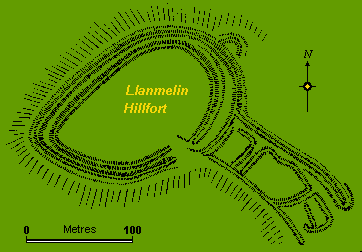
EBK Home
Kingdoms
Royalty
Saints
Pedigrees
Archaeology
King Arthur
Mail David
 LLANMELIN
LLANMELINCamelot & Celliwig Explained?
If Venta Silurum was indeed the town behind the concept of King Arthur's Chief Residence, how did it come to be given a name derived from Camulodunum?
The Theory: Barber & Pykitt extend the theory identifying Caerwent with Camelot, the Capital City of the Great King Arthur, by further explaining how the name and the place became associated with one another. They suggest that, like so many other towns after the Roman withdrawal from Britain, Venta Silurum was abandoned in favour of the nearby hillfort of Llanmelin which the High-King refortified and which may, on occasion, have been referred to by the old name of Caer-Guent. But the fortress had it's own proper name also: originally Llan-y-Gelli, which became Celliwig in Welsh legend, and then Caer-Melin (now Llanmelin). Chrétien De Troyes may well have known of Arthur's main residence by a corrupt form of this latter name. Not knowing of such a place, he mistakenly identified Caer-Melin as Ca-Mulod-unum. Thus Camelot was born!
Modern Archaeology: Llanmelin is a vast hillfort covering 1.2 hectares of the Welsh countyside. It is often assumed to have been the capital of the pre-Roman tribe of the Silures. Limited excavations, mostly concentrating on the defences, took place in 1930-32. They revealed three phases of Iron Age construction equally spaced throughout the first three centuries bc. The last phase included the addition of the large south-easterly annex, possibly as a cattle coral. The only area examined within the ramparts showed little sign of Iron Age occupation, let alone any 6th century evidence.
